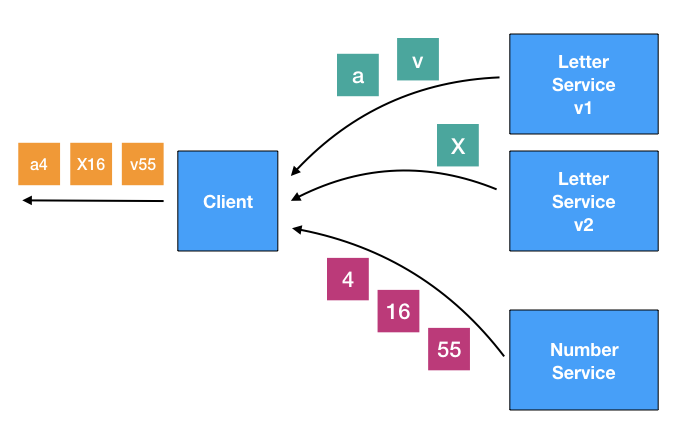netifi-requeststream-example
An example of the request-stream interaction model and aggregating streams with Netifi and RSocket.
This example aggregates two different microservices, one that emits random letters, and one that emits random numbers into letter-number pairs.
What is Netifi?
Netifi is a platform for building cloud-native applications with the power of RSocket.
Netifi provides service discovery, load-balancing, streaming, and back-pressure without deploying a whole host of infrastructure components and without polluting your code with circuit breakers and client-side load-balancing.
Project Structure
This example contains the following projects:
- client - Client application that streams and combines data from the backend services.
- letter-service-idl - Contract that defines the
letter-serviceandletter2-serviceAPIs. - letter-service - Service that generates random letters.
- letter2-service - Version 2 of the
letter-servicethat adds capital letters. - number-service-idl - Contract that defines the
number-serviceAPI. - number-service - Service that generates random numbers.
Prerequisites
This example requires a running instance of the Netifi Broker.
Run the following command to download the Netifi Community Edition Broker as a Docker container:
docker pull netifi/broker:1.6.9
Building the Example
Run the following command to build the example:
./gradlew clean build
Running the Example
Follow the steps below to run the example.
Request-Stream
Follow the steps below to run the example that shows aggregating two request-streams:
-
Run the following command to start a local Netifi Broker:
docker run -p 8001:8001 -p 8101:8101 -p 7001:7001 -p 6001:6001 \ -e BROKER_SERVER_OPTS="'-Dnetifi.broker.admin.accessKey=8833333111127534' \ '-Dnetifi.broker.admin.accessToken=Ih+hNsSdxLxAtHceTeEia2MGXSc=' \ '-Dnetifi.authentication.0.accessKey=8833333111127534' \ '-Dnetifi.authentication.0.accessToken=Ih+hNsSdxLxAtHceTeEia2MGXSc=' \ '-Dnetifi.broker.ssl.disabled=true'" \ netifi/broker:1.6.9 -
In a new terminal, run the following command to start the
number-service:./gradlew :number-service:run -
In a new terminal, run the following command to start the
letter-service:./gradlew :letter-service:run -
In a new terminal, run the following command to start the client and stream from both the
letter-serviceandnumber-service:./gradlew :client:runLettersIf successful, you will see letters and numbers aggregated together every second similar to the following:
2019-11-10 14:46:57,494 INFO e.c.RunLettersStream [reactor-tcp-nio-4] a38 2019-11-10 14:46:58,496 INFO e.c.RunLettersStream [reactor-tcp-nio-4] o75 2019-11-10 14:46:59,501 INFO e.c.RunLettersStream [reactor-tcp-nio-4] x32 2019-11-10 14:47:00,504 INFO e.c.RunLettersStream [reactor-tcp-nio-4] m84 2019-11-10 14:47:01,508 INFO e.c.RunLettersStream [reactor-tcp-nio-4] u26 2019-11-10 14:47:02,515 INFO e.c.RunLettersStream [reactor-tcp-nio-4] f41 2019-11-10 14:47:03,519 INFO e.c.RunLettersStream [reactor-tcp-nio-4] z25
Request-Response
Follow the steps below to run the example that shows aggregating request-response interactions where the letter data is load-balanced between letter-service and letter2-service:
-
In a new terminal, run the following command to start the
letter2-service:./gradlew :letter2-service:run -
In a new terminal, run the following command to start the client and load-balance between both
letter-serviceinstances and thenumber-service:./gradlew :client:runLetterIf successful, you will see letters and numbers aggregated and note that the letters are both uppercase and lowercase similar to the following:
2019-11-10 14:51:31,564 INFO e.c.RunLettersStream [reactor-tcp-nio-4] N51 2019-11-10 14:51:31,564 INFO e.c.RunLettersStream [reactor-tcp-nio-4] I84 2019-11-10 14:51:31,565 INFO e.c.RunLettersStream [reactor-tcp-nio-4] X27 2019-11-10 14:51:31,566 INFO e.c.RunLettersStream [reactor-tcp-nio-4] P97 2019-11-10 14:51:31,566 INFO e.c.RunLettersStream [reactor-tcp-nio-4] D67 2019-11-10 14:51:31,567 INFO e.c.RunLettersStream [reactor-tcp-nio-4] l1 2019-11-10 14:51:31,567 INFO e.c.RunLettersStream [reactor-tcp-nio-4] A16 2019-11-10 14:51:31,567 INFO e.c.RunLettersStream [reactor-tcp-nio-4] l32 2019-11-10 14:51:31,567 INFO e.c.RunLettersStream [reactor-tcp-nio-4] s19 2019-11-10 14:51:31,568 INFO e.c.RunLettersStream [reactor-tcp-nio-4] Y89 2019-11-10 14:51:31,568 INFO e.c.RunLettersStream [reactor-tcp-nio-4] O3 2019-11-10 14:51:31,568 INFO e.c.RunLettersStream [reactor-tcp-nio-4] K88 2019-11-10 14:51:31,569 INFO e.c.RunLettersStream [reactor-tcp-nio-4] o94 2019-11-10 14:51:31,569 INFO e.c.RunLettersStream [reactor-tcp-nio-4] I17
Bugs and Feedback
For bugs, questions, and discussions please use the Github Issues.
License
Copyright 2019 Greg Whitaker
Licensed under the Apache License, Version 2.0 (the "License"); you may not use this file except in compliance with the License. You may obtain a copy of the License at
http://www.apache.org/licenses/LICENSE-2.0
Unless required by applicable law or agreed to in writing, software distributed under the License is distributed on an "AS IS" BASIS, WITHOUT WARRANTIES OR CONDITIONS OF ANY KIND, either express or implied. See the License for the specific language governing permissions and limitations under the License.
